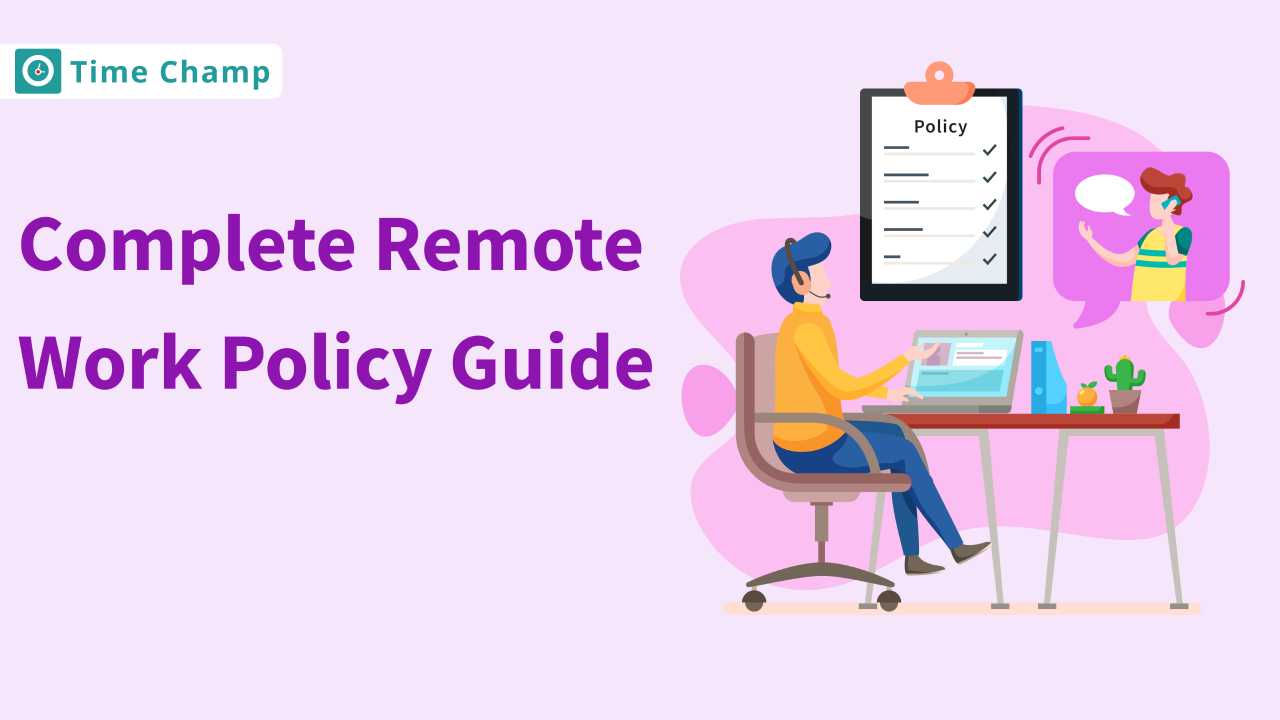I get it—remote work can be tricky. You’ve probably experimented with different strategies to stay productive, but maybe the results haven’t quite matched your expectations.
Don’t stress!
You’re in the perfect place to turn things around.
In this blog, we’ll dive into 12 powerful practices designed to help you take charge of your remote work setup and hit those productivity goals you’ve been chasing.
Why is it Important to Follow Best Practices for Remote Workers?

Boosts Productivity
When remote workers adopt good practices like time management, communication, organizing things, etc. it helps to concentrate and accomplish tasks easily. It is not just about working harder, but smarter!
The Gartner survey found that 36% of employees who have worked from home more since January 2020 reported higher productivity.
And who doesn’t love achieving goals and knocking out tasks without burning out?
Enhances Collaboration
Remote teams must be on the same page, even if they are thousands of miles away. Practices such as daily stand-ups, using communication platforms, and having clear expectations guarantee that everyone is on the same page.
Imagine a team that works like a well-oiled machine, despite being in different time zones- all thanks to best practices.
Creates a Healthy Work-life Balance
Without the structure of an office, lines between work and personal time can blur. Following practices such as setting boundaries, and taking regular breaks ensures that remote workers avoid burnout and stay refreshed.
Happy workers = better performance.
Staff retention and loyalty
Employee satisfaction has a strong impact on whether employees will look for other employment. The provision of the opportunity to work from home by following best practices improves the work-life balance, which can make employees more willing to stay.
Fact: According to McKinsey, 30% of employees might search for a new job if their company returned to a fully on-site work environment after the pandemic.
Builds Trust and Accountability
Best practices make it clear that work gets done on time, even without a manager hovering over your shoulder. It establishes a culture of accountability, which not only drives trust but also leads to more independence and confidence.
These are just a few of the many benefits that come from following best practices in remote work.
What are the Challenges of Working Remotely?

Navigating the remote work landscape presents unique hurdles that challenge your productivity and collaboration.
Let’s have a look at them:
Isolation
Remote work can lead to disconnection from the team and organizational culture. Lack of face-to-face communication can make employees feel isolated from co-workers, which can impact the cohesiveness and motivation of the workers.
Communication Issues
Remote work may involve the use of technology for communication, and this may cause misunderstandings or delayed responses. There is no direct communication, which may lead to misinterpretation of the tone and urgency of the message, and thus, hinder effective collaboration in a team.
Work-Life Balance
Lack of a physical office presence can be challenging for you to draw a line between work and personal life. This can lead to working more hours, inability to switch off from work-related tasks, and even increased likelihood of burnout.
Distractions
There are always many distractions at home, for example, cleaning, pets, or other family members. These interruptions can interfere with concentration and reduce the overall efficiency of work, which in turn makes it difficult to concentrate on work-related activities.
Technology Problems
Remote work relies on technology, and things like slow internet connection, technical problems, or software failure can slow down productivity and create stress. These problems can cause time wastage in completing tasks and impacts on efficiency.
12 Best Practices for Remote Work
As we’ve seen, the common challenges of remote workers. Below are 12 best practices that you as a remote employee should follow for successful results.
1. Plan Your Day with a Clear Routine
It is crucial to set a daily schedule to ensure that you are productive when working from home. Start with the time management by defining the working hours of the day. Divide your day according to tasks, include time for meetings, and do not forget about breaks.
A well-defined routine not only makes work easier but also helps to establish new normalcy in your work-from-home.
2. Create Boundaries between Work and Personal Life
One of the challenges that are likely to be experienced when working remotely is the blurred boundary between work and personal time. You have to ensure that work doesn’t interfere with your time.
This can involve setting certain hours for work, refraining from work during other hours, and informing the family, friends, and co-workers of these hours, etc. Work-life balance helps to minimize stress and avoid cases of burnout.
3. Create a Dedicated Workplace
It is important to have a specific area for work to concentrate on the tasks at hand. This could be a home office, a corner of a room, or even a separate desk for working.
The idea is to set up conditions that would tell the brain, ‘It’s time to work’ when you are in the space. Try to make your working area as comfortable as possible to enhance your productivity, but do not make it too comfortable so that you would not want to leave it.
4. Take Regular Breaks
Better to take breaks to refresh your mind and body as well as to avoid exhaustion. Take a break from your work every hour and move around, whether it could be stretching your legs or get a drink.
Short breaks are effective in rejuvenating the mind from getting exhausted and hence increasing productivity. It is possible to use such methods as the Pomodoro Technique, etc. for better productivity.
5. Connect with Your Co-workers
Working remotely can be quite lonely, it is important to remain in touch with your co-workers for effective cooperation and morale. Set up weekly or bi-weekly phone or video conferences to talk about work and catch up on each other’s progress.
Instant messaging and video conferencing can also mimic some of the social interactions possible in an office environment, which can help build better team cohesiveness.
6. Be Accountable
Be accountable for what you are responsible for. Make sure to complete the tasks within the set deadline. When employers conduct weekly or bi-weekly audits, you should be able to present what you have done and able to discuss the plans for your work. This gives a clear picture for both you and your employer about the progress that you have made.
7. Maintain Clear Communication
To have a clear communication with your colleagues, it is crucial to employ tools such as Slack, Microsoft Teams, or Zoom. These platforms assist you to remain informed and in synch. But do not forget that technology isn’t perfect and sometimes there may be some problems too!
To prevent misinterpretation, always confirm the content of critical messages and follow up if no response is received within a short time.
8. Plan Your Tasks
Planning your tasks becomes important when you don’t have a physical presence in the office. At times, it becomes quite challenging to handle situations due to factors such as your environment or the people you interact with.
With time management techniques, you can easily manage things that are on your schedule. Research has shown that effective time management leads to productivity and effectiveness at the workplace regardless of the employee’s position.
9. Be Active and Attentive While Working
Imagine you didn’t respond to an important mail that you have been waiting to receive for over a week.
When you are working remotely, they might think you are chilling and being unproductive.
To avoid such misconceptions, it is essential to stay visible by being active and attentive during working hours.
For instance, give quick replies to messages, and comments, and regularly connect with your teammates, etc.
10. Experiment with Productivity
It is important to understand that not all productivity methods are suitable for everyone, so do not hesitate to try.
Experiment with methods such as time boxing, time blocking, Pomodoro technique to find out which one is effective for you. Always optimize your workflow to the highest level of efficiency.
11. Dress for Work
Although it is comfortable to work in pajamas, dressing for work can influence your attitude toward work in a big way. Wearing formal clothes as if you are going to work can assist in creating a work environment and culture. It can also help you to gain confidence and enhance your performance when attending virtual meetings. It is possible to be both comfortable and neat, so finding a balance between the two is achievable.
12. Keep Your Tech Reliable and Ready
Reliable technology is one of the most important aspects of a successful remote work environment. Make sure that you have a good connection to the internet and update your software and hardware regularly.
Always copy files that are crucial to your work and have a backup plan in case of technological breakdowns. Dependable technology reduces interruptions and ensures efficiency in the working process.
Remote Work Best Practices for Employers
As an employer, you have a set of best practices to ensure remote work is successful and productive for everyone involved.
Here’s how they can support and enhance the remote work experience.
1. Get Feedback
One of the most important things you can do to support remote employees is to ask for regular feedback. This doesn’t have to be complicated—simple surveys, one-on-one meetings, or informal check-ins can work wonders.
The goal is to understand what’s working and what isn’t for your team. Remote work comes with its own set of challenges, and the only way to improve the experience is by listening to your employees. When they see that their input is valued and acted upon, it fosters a culture of trust and openness.
2. Be Open to Embrace Diversity
If you have employees working from home from different countries, it is crucial to know their work culture. Also, be receptive to their ideas and opinions as these can be beneficial to your business.
3. Understand Your Organization’s Remote Work Policy
You and your team must have a proper and well-established remote work policy. The policy must be fully understood by you as an employer and it should also be effectively communicated to the rest of the team. The policy also needs to be revised periodically as new technologies emerge or new issues come up. It is important to keep the guidelines clear so that everyone is on the same page and there is no misunderstanding.
4. Offer Training Opportunities
Yes! Remote employees also need training as much as in-office employees, so it is crucial not to dismiss the training opportunities as a result of remote work. Better to invest in online learning resources for remote workers.
For instance, digital libraries, online learning platforms, webinars, etc.
5. Recognize Success
It is crucial to recognize the efforts and accomplishments of your remote employees to ensure they remain motivated and productive. Since there is no direct interaction in the office, achievements can be overlooked.
Try to find ways to reward and appreciate the efforts made by the employees. This can be done verbally during meetings, through emails, or even by providing incentives. Acknowledging achievements, no matter how small, not only increases the motivation of employees but also the unity of the team.
Final Thoughts
In conclusion, it’s important for you to follow best practices for remote work to maintain your productivity, collaborate effectively, and achieve a healthy work-life balance. By creating a solid routine and keeping in regular contact with your team, you can overcome the difficulties associated with working remotely. These habits not only increase output but also foster a sense of teamwork and professional pleasure.
Boost your remote work productivity with Time Champ’s time tracking—start your free trial today!
Signup for FreeBook DemoFrequently Asked Questions
One of the difficulties of working remotely is to maintain motivation during large projects. To keep yourself motivated, it is advisable to subdivide the project into smaller tasks with achievable goals. It is important to look for ways to keep the momentum going by focusing on the small successes. You can also set personal rewards after each milestone, which can be a cup of coffee, a short walk, or something you enjoy.
To avoid being overwhelmed by technology, schedule certain periods when you will not be using your gadgets. For example, do not check your emails or work applications after working hours. You can also use “Do Not Disturb” modes to avoid notifications during focus time. Remember to engage in non-screen activities throughout the day, for example, exercise, reading a book, etc.
The first step towards enhancing your video call presence is to prepare adequately. Make sure that the environment you select for meetings is noise-free and has adequate lighting. Make sure to sit in front of the camera at eye level and wear proper clothes as it adds to the professional look. Pay attention during meetings and ensure that your non-verbal communication indicates that you are listening, for instance, nodding or maintaining eye contact.
Zoom fatigue is one of the biggest issues that people face when working remotely. Schedule some time gaps between the meetings for a short break to help the mind relax. Reduce the frequency of meetings and opt for other forms of communication such as emails or project management tools where possible. If meetings are unavoidable, prefer shorter and specific meetings rather than one-hour meetings.







